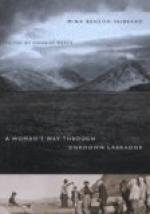The trappers told us that, going by the river, it would take a month to reach Seal Lake. I wished very much to keep to the river route, because Mr. Hubbard would have had to do so had he not missed the way, there being no Indians within reach, at the time he made his journey, from whom we could obtain information. Yet our time was short. From an Indian, whom we found at Northwest River, I had a map of the portage; but it was crude, and we should not be able to make the trip as quickly as the Indians even at best. It was quite possible that a good deal of time might have to be spent looking for the trail, for it was old and would not be easily found. It was hard to decide what was best to do.
Going ashore the men hastily examined the trail. The council which followed resulted in a decision to keep to the river. The work would be harder, but we should probably make as good progress and reach Seal Lake as soon as by going through the lakes.
Above this point the river swings more to the north, and the current grows swifter as you ascend. A little before noon we landed at Point Lucie, a high, sandy point, which stands out into the river at the foot of the first rapid. Here the trappers leave their boats and make no attempt to take canoes farther up, but portage their provisions and traps the remaining 40 miles to Seal Lake. It seemed quite thrilling to have arrived at the wonderful rapids I had heard so much about. It made me tremble a little to think of sometimes being on them in a canoe, for there was so much water, and the river looked so big.
Below Point Lucie a broad bed of loose rocks reached high up at its foot, and in the curve of the point were great sand and gravel-covered hummocks of ice. For some distance below us the farther and right bank of the river was lined with huge ice-banks, still 10 and 12 feet thick, which extended up almost to where the river came pouring out from the foot of Mount Sawyer, in a leaping, foaming torrent. At this point the river spread out over a bed of loose rocks about half a mile wide, which broke the water into channels, the widest, deepest, and swiftest of which flowed along the farther shore. The smaller and shallower ones curved into the bay above Point Lucie. A short distance above us several of these united, and from there the water was deep and swift and poured round Point Lucie with tremendous force. Around the curve of the bay and stranded in the river-bed were more ice-banks.
While George, Joe, and Gilbert were busy preparing lunch Job disappeared into the woods. Some time later he came back with four stout dry poles. They were about nine feet long and two and a half inches in diameter at the lower end. After lunch the work of shaving and shoeing them began, and the crooked knife came into use. It was fine to watch Job’s quick, deft strokes as he made them ready. The “shods” George had brought from Missanabie. These were made at Moose Factory, and were the kind used throughout the James Bay country. They were hollow cone-shaped pieces of iron a quarter of an inch thick and open down one side, so that they might not break with the strain. They were 4 inches long, rounded and solid at the small end, and on either side, about an inch from the top, was a hole to admit the nail which fastened the pole in place. When finished they looked as if meant for heavy work.




